-
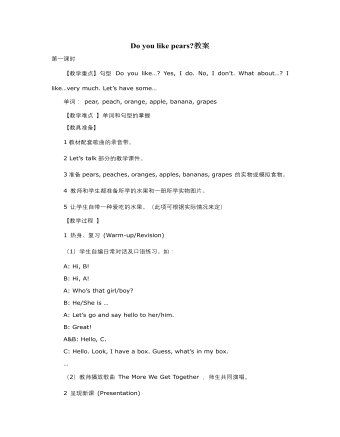
人教版新课标PEP小学英语三年级下册Do you like pears教案
教师扮做客人,让孩子根据问题做出反应并回答。 Can I have an apple? Can I have some grapes? Let’s sing 播放歌曲的录像,先观看一遍, 帮助孩子理解歌曲。 孩子边唱边表演。 小组表演,小组展示。 (四) 扩展性活动(Add-activities) Coloring Draw some grapes, color them red Draw a banana,color it green. …, …【板书设计 】Do you like pears? Do you like pears? 第五课时第六课时【课题】Do you like pears? 第六课时 【教学重点】听、说、认读字母Rr Ss Tt,体会字母在单词中的发音 【教学难点 】字母Ss的发音。Tiger中字母I的发音 【教具准备】 1、本课生词的单词卡片 2、配套的教学课件 3、相配套的教学录音带 4、学生的小英语练习本 5、大字母卡片,每组一套的小字母卡片 【教学过程 】 (一)热身/复习(Warm-up/Revision) 1、Let’s sing 演唱B部分的歌曲,边唱边演。
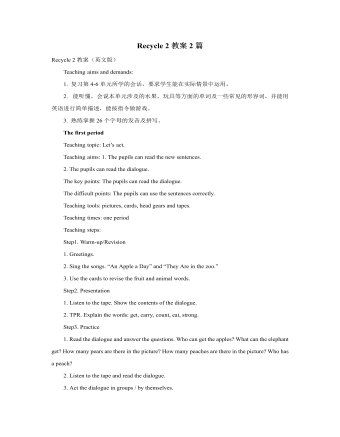
人教版新课标PEP小学英语三年级下册Recycle 2教案2篇
第三课时教学设计方案【教学内容和目标】【教学重点】 制作键盘; 学唱英文歌曲 “A B C Song ”。【教学难点】复习过程中的兴趣培养;【教具准备】1 教材配套的录音带。2 教师和学生分别准备废旧的硬纸盒/纸版、剪刀、胶水。3 教师准备一个自己已制作好的键盘。4 教师准备字母卡片和真正的键盘一个。【教学过程】1 热身、复习 (Warm-up/Revision)(1)师生之间进行英语对话或进行日常口语活动。(2)学生之间自编对话并表演。(3)教师播放B Let’s chant 的录音,让学生边拍手边说歌谣。(4)游戏:Silent Speech教师换一种方法说字母------唇说,说字母的时候不发出声音。学生看教师的口形,猜教师“说”的内容。说的字母为Aa----Zz 。2 呈现新课 (Presentation)(1)教师出示字母卡片,学生认读字母Aa----Zz。(2)学生字母背诵Aa----Zz。(3)教师播放歌曲 “A B C Song ”,告诉学生“试一试”“比一比”,看看谁能通过自己试唱学会歌曲。
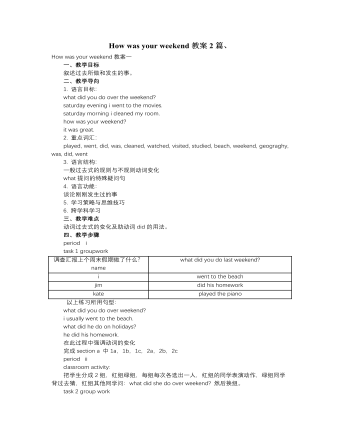
人教版新目标初中英语七年级下册How was your weekend教案2篇
Teaching Goal:1. General aims:Talk about recent past events2. Particular aims:A. Language Focus.Talk about recent past events and think of the past events.B. Language goalsHow was….?It was …What did …do over the weekend?C. Language structures:(1). How was your weekend? I was great. Pay attention to no form.(2). What did you do over the weekend? I played soccer. We went to the beach.D. Useful words and phrases:Words: was, did, went, beach, over, project, test, wasn’t, false, number, geography, spend, week, most, mixture, their, had, little, cook, read, saw, change, everyone, sit, sat, no, anythingPhrases: did one’s homework, played soccer, cleaned my room, went to the beach, played tennis, went to the movies, on Saturday morning, over the weekend, cook … for, what about, do some reading, have a party, talk show, go shoppingE. Grammar language:Present simple past tenseRegular and irregular verbsF. Learning strategies:Tour and holidaysG. Interdiscipinary:H. Emotion and manner:Teaching time: 5 periodsTeaching procedures:Period One教学步骤、时间 教师活动 学生活动 媒体应用Step 1Free talk 3’ Ask some questions like:Who’s on duty today?What’s the weather like? Answer and talk about something.让同学们回答下列问题1. Do you like weekend? (Let some students answer)It takes them three minutes to talk about the question.2. Why do you like weekend? (let the students answer) Most of the students like the weekend此时教师用汉语问:“在周末期间问你干了什么?这句话用英语这么回答?Let the students guess.At last the teacher give them right answer3. What did you do over the weekend?(板书、学习)
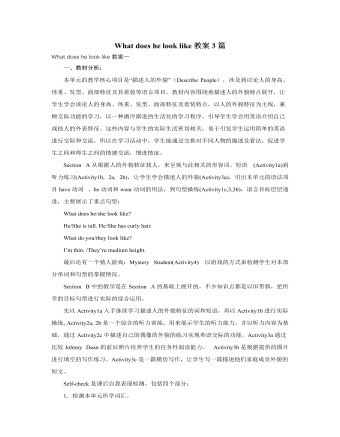
人教版新目标初中英语七年级下册What does he look like教案3篇
所需要用到的句子:Who is that?That is Jack. I like him.Why do you like him?I like him because he is interesting.Task 4: 设计理想中的人类Step one: 设计理想中的人类的外貌。把全班同学分成若干小组,学生可以边说边在纸上画出他们的模样。Step two: 设计理想中人类的性格。学生们可以把那些能描述性格的单词写在图画的旁边。Step three: 每组选出一名同学,其他同组同学提问,他作简单回答,并说明原因。所需用到的句子:What does he or she look like?He or she ...What is he or she like?He or she is ...Why?Because ...Task 5: 挑战性活动调查性格是天生的还是后天形成的,让每个同学回家去调查一下自己成长过程中性格是否有变化,具体是怎样的,为什么会这样? Teaching Aims:1. Enable students to have a general understanding of how to talk about people's physical appearance.2. Enable students to tackle some essential vocabularies and patterns about describing people. Provide them with necessary skills and methods.3. Create various chances for students to describe the persons they're familiar with, such as classmates, family members, teachers, idols, etc.
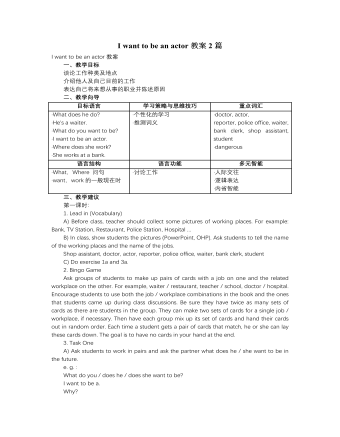
人教版新目标初中英语七年级下册I want to be an actor教案2篇
三、教学建议第一课时:1. Lead in (Vocabulary)A) Before class, teacher should collect some pictures of working places. For example: Bank, TV Station, Restaurant, Police Station, Hospital ...B) In class, show students the pictures (PowerPoint, OHP). Ask students to tell the name of the working places and the name of the jobs.Shop assistant, doctor, actor, reporter, police office, waiter, bank clerk, studentC) Do exercise 1a and 3a.2. Bingo GameAsk groups of students to make up pairs of cards with a job on one and the related workplace on the other. For example, waiter / restaurant, teacher / school, doctor / hospital. Encourage students to use both the job / workplace combinations in the book and the ones that students came up during class discussions. Be sure they have twice as many sets of cards as there are students in the group. They can make two sets of cards for a single job / workplace, if necessary. Then have each group mix up its set of cards and hand their cards out in random order. Each time a student gets a pair of cards that match, he or she can lay these cards down. The goal is to have no cards in your hand at the end.3. Task OneA) Ask students to work in pairs and ask the partner what does he / she want to be in the future.e. g. :What do you / does he / does she want to be?I want to be a.Why?Because it's (adj).B) Vocabulary: Section B, 1a4. Homework 1.2.
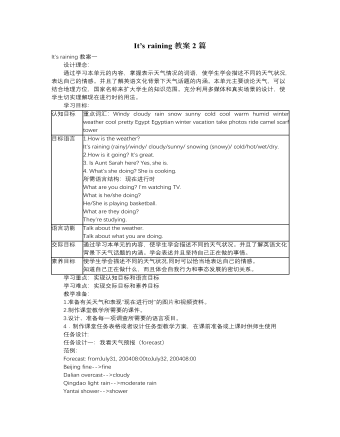
人教版新目标初中英语七年级下册It’s raining教案2篇
1 Each group choose one place to describe and what you are doing in it Choose one place, and describe what they are doing 2 Move around the room and give suggestions Talk about it and write it down 3 Ask one to show their works and act it Choose one of each group to make a report 4 Evaluate the best group and the best reporter Choose the best one Homework Ask your friends their ideal place and write about it教学反思:新课程标准中强调学生在课堂中的主体地位,在综合课中他们的主体地位就更加突出。在各个活动中给不同程度的学生不同层次的任务,让各层面的学生都有表现发挥的机会,从而产生对英语的兴趣。使用照片图片多媒体来辅助教学,效果更好。同时让了解其他国家风景,风俗的同学介绍ideal place,增加学生的背景知知识,实现跨学科交流的目的。教案点评:采用任务型教学模式,在各个活动中给不同程度的学生不同层次的任务,让各层面的学生都有表现发挥的机会,从而产生对英语的兴趣。使用照片图片多媒体来辅助教学,效果更好。让了解其他国家风景,风俗的同学介绍ideal place,增加学生的背景知识,实现跨学科交流的目的。
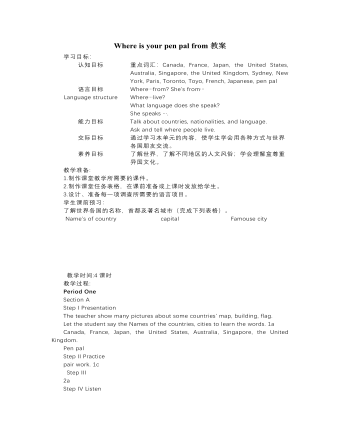
人教版新目标初中英语七年级下册Where is your pen pal from教案
2.1Match the country with the language.Step II Reading3a? let the students read the letter fast and answer the questions.? Let the students ask more questions about the letter as possible as the can.Step III Writing3b.Step IV. Pairwork2cStep V Listening2a, 2bStep V. HomeworkExercises book(1) P3Exercises book (2) P3Period FourStep I . Dictate the words and sentences in Unit1.Step II. Self-checkStep III. Check the answers for Exercises book in the unit.Step IV. Home workRevise and preparation for unit 2.教学反思:通过本单元的学习,学生基本可以谈论人们的国籍,居住城市及其所说的语言,通过书信方式去介绍自己并寻找笔友。但在涉及到国外的一些城市时,学生对这方面的知识相对欠缺,能介绍的城市并不多,也反应出学生课前预习不充分,这跟学生学习条件也有关,大多数学生无法通过网络获取所需信息。因此,在以后的教学中要多指导学生通过计算机网络获取信息,拓宽知识面。
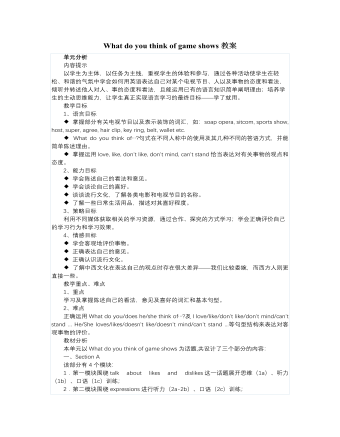
人教版新目标初中英语七年级下册What do you think of game shows教案
五、教学Section B-2c1. Pair work: What do you think of the belt/sunglasses/…? What does your father/mother/… think of your scarf/belt…?2. Group work(1). Teacher shows some different kinds of school uniforms (制服)and asks : “ What do you think of your school uniforms? If you have a chance to choose your school uniforms, what kind would you like to choose?”(2). Discuss in groups.(3).Get some Ss to report in class.说明:这一步旨在让学生运用已有的语言知识谈论对事物的看法和意见,并简单阐明理由,培养学生的主动思维能力和运用英语的能力。六、教学拓展调查电视节目的收视率任务:调查你周围的人对现在各种电视节目的反响。活动过程:1.教师布置任务,让学生调查周围的人(包括他的亲戚朋友和邻居)喜欢收看哪方面的电视节目。2.学生进行调查活动,运用本单元所学的句型What do you think of….? (Why?)What's your favorite game shows?What do you think of talk show?I doesn’t mind it.I like it.I love it.I can’t stand it.3.记录下排在前10位的TV Program,填写调查表,比较其收视率。

人教版新目标初中英语八年级下册Have you ever been to an amusement park教案
(1)Have you ever been to …? Yes, I have. / Yes, I have ever been to …No, I haven’t. / No, I have never been to …(2)When did you go there? I went there last year. (3)I have never been to a water park. Neither have I. I have ever been to an amusement park. So have I. (4)How long have you been studying English? I’ve been studying English since nine o’clock. I’ve been studying English since I came back home. I’ve been studying English for five hours. (5)What’s that? It’s an amusement park in Japan. I’ve never been to an amusement park like it before. It’s fun to learn another language. Let’s go tonight. Isn’t this great?space museum, amusement park, water park, South America, Peru, Holland, European culture, tour guide, flight attendant, musical instrument, more than, be from, get to, take lessons, neither, discover, graduate, change
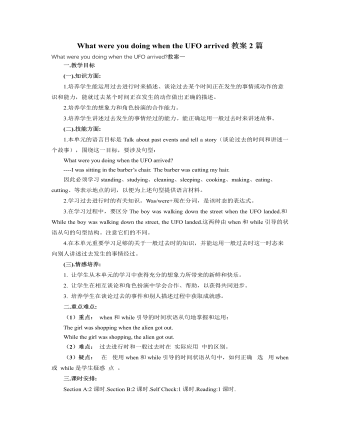
人教版新目标初中英语八年级下册What were you doing when the UFO arrived教案2篇
(一).知识方面: 1.培养学生能运用过去进行时来描述、谈论过去某个时间正在发生的事情或动作的意识和能力,能就过去某个时间正在发生的动作做出正确的描述。 2.培养学生的想象力和角色扮演的合作能力。 3.培养学生讲述过去发生的事情经过的能力。能正确运用一般过去时来讲述故事。 (二).技能方面: 1.本单元的语言目标是Talk about past events and tell a story(谈论过去的时间和讲述一个故事),围绕这一目标,要涉及句型: What were you doing when the UFO arrived? ----I was sitting in the barber’s chair. The barber was cutting my hair. 因此必须学习standing、studying、cleaning、sleeping、cooking、making、eating、cutting、等表示地点的词,以便为上述句型提供语言材料。2.学习过去进行时的有关知识。Was/were+现在分词,是该时态的表达式。 3.在学习过程中,要区分The boy was walking down the street when the UFO landed.和While the boy was walking down the street, the UFO landed.这两种由when和while引导的状语从句的句型结构。注意它们的不同。
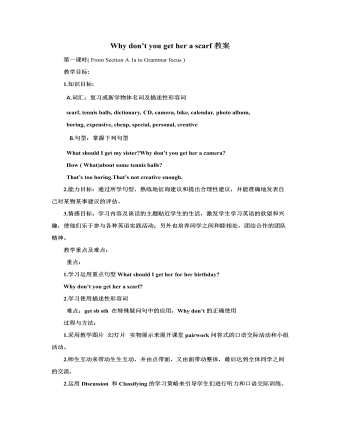
人教版新目标初中英语八年级下册Why don’t you get her a scarf教案
教师带领学生复习有关描述宠物的词汇,采用教师提问学生回答的方进行。如:T:What animals do you think would be good pets?What animals do you think would be bad pets?What do you think are good animals for a six-year-old child?然后学生进行 pairwork 练习。Task two: 师生互动,学习探究 1、播放3a部分的录音,引导学生一边听录音,一边跟读。2、通过听录音学生回答以下问题:Why do you think pot-bellied pigs are popular?What are the advantages and disadvantages of keeping such a pet?教师对学生的回答进行及时点评。3.学习范文,学习重点短语,为下步的模仿写作提供语言素材。T :1. )Have you ever kept a pig as a pet?Do you like pigs? St.:No.…Why don’t you like to keep a pig? St: No.They’re too dirty and lazy(Do you know in some foreign countries like Hollyland, Australia,pigs are the most popular pet.there’s a kind of pig.(图)it has an interesting name? it ‘s called a pot-bellied pig.) Now,let’s learn an article about this kind of interesting pet.2.)play the tapeSt.:Listen and repeat3.)show some Qs on computer(本子St.: read silently,then answerthe Qs(本子)4.)Ask ss. Close book and retell this passage.(what is a pot-bellied pig? Is it a good or bad pet? ) St.: retell it to each other“A pot –bellied pig is a popular pet now…”5.read the article together.St.:.practice reading
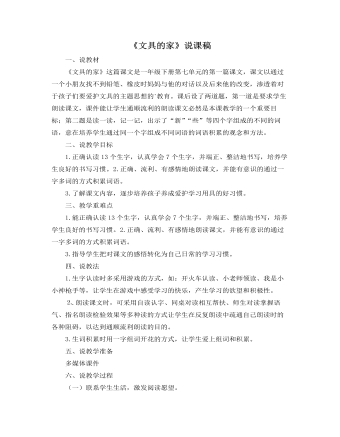
部编人教版一年级下册《文具的家》说课稿
一、说教材《文具的家》这篇课文是一年级下册第七单元的第一篇课文,课文以通过一个小朋友找不到铅笔、橡皮时妈妈与他的对话以及后来他的改变,渗透着对于孩子们要爱护文具的主题思想的`教育。课后设了两道题,第一道是要求学生朗读课文,课件能让学生通顺流利的朗读课文必然是本课教学的一个重要目标;第二题是读一读,记一记,出示了“新”“些”等四个字组成的不同的词语,意在培养学生通过同一个字组成不同词语的词语积累的观念和方法。二、说教学目标1.正确认读13个生字,认真学会7个生字,并端正、整洁地书写,培养学生良好的书写习惯。2.正确、流利、有感情地朗读课文,并能有意识的通过一字多词的方式积累词语。3.了解课文内容,逐步培养孩子养成爱护学习用具的好习惯。
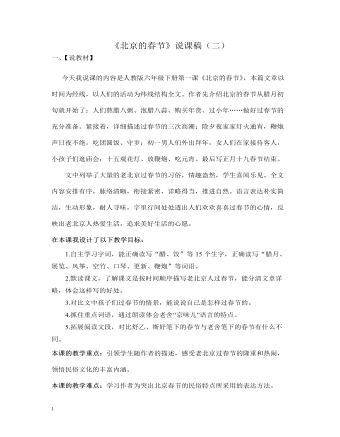
部编人教版六年级下册《北京的春节》说课稿(二)
一、【说教材】今天我说课的内容是人教版六年级下册第一课《北京的春节》,本篇文章以时间为经线,以人们的活动为纬线结构全文。作者先介绍北京的春节从腊月初旬就开始了:人们熬腊八粥、泡腊八蒜、购买年货、过小年……做好过春节的充分准备。紧接着,详细描述过春节的三次高潮:除夕夜家家灯火通宵,鞭炮声日夜不绝,吃团圆饭、守岁;初一男人们外出拜年,女人们在家接待客人,小孩子们逛庙会;十五观花灯、放鞭炮、吃元宵。最后写正月十九春节结束。文中列举了大量的老北京过春节的习俗,情趣盎然,学生喜闻乐见。全文内容安排有序,脉络清晰,衔接紧密,详略得当,推进自然。语言表达朴实简洁,生动形象,耐人寻味,字里行间处处透出人们欢欢喜喜过春节的心情,反映出老北京人热爱生活,追求美好生活的心愿。
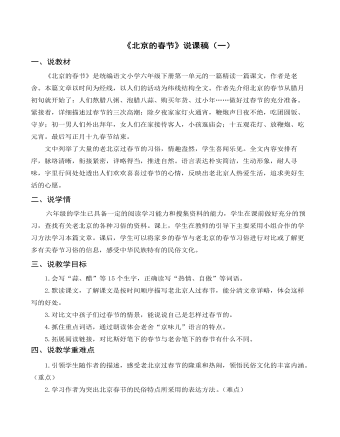
部编人教版六年级下册《北京的春节》说课稿(一)
二、说学情六年级的学生已具备一定的阅读学习能力和搜集资料的能力,学生在课前做好充分的预习,查找有关老北京的各种习俗的资料。课上,学生在教师的引导下主要采用小组合作的学习方法学习本篇文章。课后,学生可以将家乡的春节与老北京的春节习俗进行对比或了解更多有关春节习俗的信息,感受中华民族特有的民俗文化。三、说教学目标1.会写“蒜、醋”等15个生字,正确读写“热情、自傲”等词语。2.默读课文,了解课文是按时间顺序描写老北京人过春节,能分清文章详略,体会这样写的好处。 3.对比文中孩子们过春节的情景,能说说自己是怎样过春节的。 4.抓住重点词语,通过朗读体会老舍“京味儿”语言的特点。 5.拓展阅读链接,对比斯妤笔下的春节与老舍笔下的春节有什么不同。
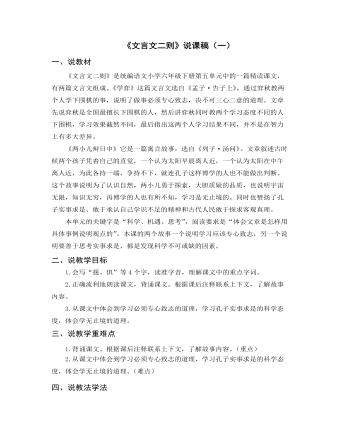
部编人教版六年级下册《文言文二则》说课稿(一)
一、说教材《文言文二则》是统编语文小学六年级下册第五单元中的一篇精读课文,有两篇文言文组成。《学弈》这篇文言文选自《孟子·告子上》,通过弈秋教两个人学下围棋的事,说明了做事必须专心致志,决不可三心二意的道理。文章先说弈秋是全国最擅长下围棋的人,然后讲弈秋同时教两个学习态度不同的人下围棋,学习效果截然不同,最后指出这两个人学习结果不同,并不是在智力上有多大差异。《两小儿辩日中》它是一篇寓言故事,选自《列子·汤问》。文章叙述古时候两个孩子凭着自己的直觉,一个认为太阳早晨离人近,一个认为太阳在中午离人近,为此各持一端,争持不下,就连孔子这样博学的人也不能做出判断。这个故事说明为了认识自然,两小儿勇于探索,大胆质疑的品质,也说明宇宙无限,知识无穷,再博学的人也有所不知,学习是无止境的。同时也赞扬了孔子实事求是、敢于承认自己学识不足的精神和古代人民敢于探求客观真理。

部编人教版六年级下册《文言文二则》说课稿(二)
3.教学要求:知识能力训练点:学生通过教师引导以及小组自主合作,能根据课后注释疏通全文,了解故事内容。能有感情地朗读课文,背诵课文,做到正确、节奏停顿得当、抑扬顿挫,从反复诵读中初步感悟文言文中特殊的语言现象。过程方法引导点:通过教师引导,学生自悟自得,初步了解文言文学习的方法。(根据注释、联系上下文读通、读懂、熟读成诵。)情感态度渗透点:学生能从文中体会到做事必须专心致志,不可三心二意的道理。能从课内外延伸结合中进一步了解我国辉煌灿烂的古代文化,增加学生学习语文的兴趣,全面提高学生语文综合素养。4.教学重难点:古文与现代白话文相比,在用词造句上截然不同,能否正确地断句,流利地朗读,是首先遇到的困难。因此要把指导学生朗读和背诵作为本课教学重点。从理解课文方面看,难点在于让学生参考课后注释读懂每句话的意思,整体感知课文内容,所以要将此点作为难点来突破。由此可见,两者相辅相成,互相渗透,而利用CAI课件为学生提供形象生动的画面,创设情境加强对学生朗读的指导是突破本课教学重难点的关键。
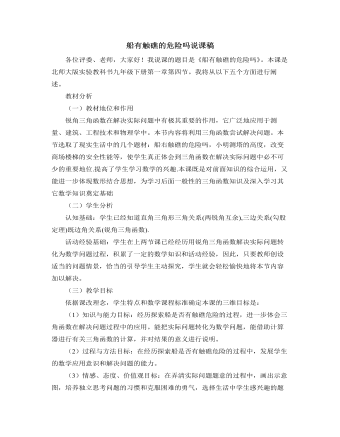
北师大版初中数学九年级下册船有触礁的危险吗说课稿
5、板书设计 §1.4船有触礁的危险吗 一、船布触礁的危险吗 1.根据题意,画出示意图.将实际问题转化为数学问题. 2.用三角函数和方程的思想解决关于直角三角形的问题. 3.解释最后的结果. 二、测量塔高 三、改造楼梯 五布置课后作业: 习题1.6第12 3题 六、设计说明 具有现实意义和挑战性的内容的设计,激发学生的学习兴趣,使学生乐学。 开放性实践问题和分层作业的设置,满足每个学生的学习需求,使学生愿学。 多样的学习方式和适时引导,提高学生的学习质量,使学生能学。 背景多样,层层递进,适时反思,发展学生的数学思维能力,使学生活学。 当学生乐学、愿学、能学、活学时,就将学会学习,将学习当成乐趣,作为生命中不可或缺的部分,也为学生终生学习奠定良好的基础。
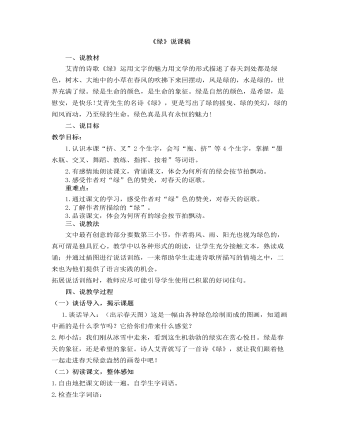
部编人教版四年级下册《绿》 说课稿
二、说目标教学目标:1.认识本课“挤、叉”2个生字,会写“瓶、挤”等4个生字,掌握“墨水瓶、交叉、舞蹈、教练、指挥、按着”等词语。2.有感情地朗读课文,背诵课文,体会为何所有的绿会按节拍飘动。3.感受作者对“绿”色的赞美,对春天的讴歌。重难点:1.通过课文的学习,感受作者对“绿”色的赞美,对春天的讴歌。2.了解作者所描绘的“绿”。3.品读课文,体会为何所有的绿会按节拍飘动。三、说教法文中最有创意的部分要数第三小节,作者将风、雨、阳光也视为绿色的,真可谓是独具匠心。教学中以各种形式的朗读,让学生充分接触文本,熟读成诵;并通过插图进行说话训练,一来帮助学生走进诗歌所描写的情境之中,二来也为他们提供了语言实践的机会。拓展说话训练时,教师应尽可能引导学生使用已积累的好词佳句。
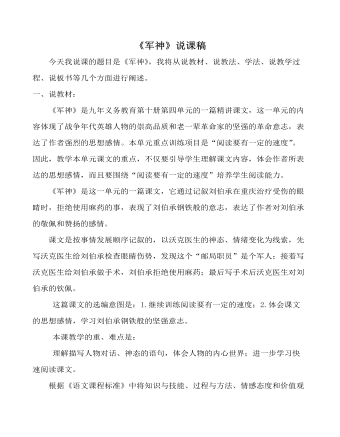
部编人教版五年级下册《军神》说课稿
一、说教材:《军神》是九年义务教育第十册第四单元的一篇精讲课文,这一单元的内容体现了战争年代英雄人物的崇高品质和老一辈革命家的坚强的革命意志,表达了作者强烈的思想感情。本单元重点训练项目是“阅读要有一定的速度”。因此,教学本单元课文的重点,不仅要引导学生理解课文内容,体会作者所表达的思想感情,而且要围绕“阅读要有一定的速度”培养学生阅读能力。《军神》是这一单元的一篇课文,它通过记叙刘伯承在重庆治疗受伤的眼睛时,拒绝使用麻药的事,表现了刘伯承钢铁般的意志,表达了作者对刘伯承的敬佩和赞扬的感情。课文是按事情发展顺序记叙的,以沃克医生的神态、情绪变化为线索,先写沃克医生给刘伯承检查眼睛伤势,发现这个“邮局职员”是个军人;接着写沃克医生给刘伯承做手术,刘伯承拒绝使用麻药;最后写手术后沃克医生对刘伯承的钦佩。
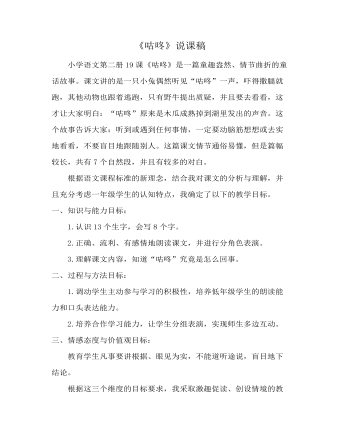
部编人教版一年级下册《咕咚》说课稿
一、创设情境,设置悬念,激趣导入。好的开端是一堂课成功的一半。正因为如此,我运用激趣导入,进行猜谜语、听声音比赛。利用课件引导学生的听觉、视觉、思维想象多渠道运作起来,积极参与到学习中。而且我还特别设计了个别声音用耳朵比较难以辨别,学生只好用眼睛揭开谜底,从而初步接触课文“眼见为实”的主旨。最后出示“咕咚”的声音,让学生猜猜这样的声音通常在什么情况下会出现,激发他们的想象力。让学生模拟发“咕咚”声,从而引出课题。并且告诉大家:千万别小看这个有点奇怪的声音,它可在森林中掀起了一场不大不小的风波呢。





















